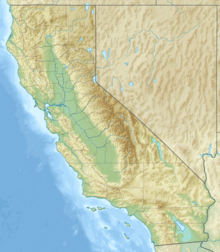Clipper Mountains facts for kids
Quick facts for kids Clipper Mountains |
|
|---|---|
| Highest point | |
| Peak | Clipper Mountain |
| Elevation | 4,625 ft (1,410 m) |
| Geography | |
| Country | United States |
| State | California |
| District | San Bernardino County |
| Range coordinates | 34°45′15″N 115°24′59″W / 34.75417°N 115.41639°W |
| Topo map | USGS West of Blind Hills |
The Clipper Mountains are a mountain range in the eastern Mojave Desert. They are located in San Bernardino County, California. These mountains are a protected area within the Mojave Trails National Monument.
Contents
Where Are the Clipper Mountains?
The Clipper Mountains run alongside Interstate 40. They are also near the historic Route 66. You can find them southeast of the Granite Mountains. They are also north of the Old Woman Mountains. The small towns of Essex and Goffs are to their northwest.
The mountains have at least three natural springs. These are places where water comes out of the ground. There is also an old place called the 'Tom Reed Mine' here.
Exploring the Clipper Mountain Wilderness
A special protected area called the Clipper Mountain Wilderness is found on the northern slopes. This wilderness is also part of the Mojave Trails National Monument. It has interesting landscapes with rugged, striped mesas. Mesas are flat-topped hills with steep sides.
You can find narrow canyons with hidden springs. There are also gently sloping areas called alluvial fans. The mountains themselves are made of volcanic rock. The highest point is Clipper Mountain, reaching about 4,625 feet (1,410 meters) high. It has sharp cliffs that look over the Fenner and Clipper Valleys. A famous rock formation called Castle Dome can be seen from Historic Route 66.
Plants and Flowers
The main plants here are desert shrubs. You will see many creosote bushes. In the spring, the alluvial fans become bright yellow. This is from the beautiful flowers of the brittlebush. Many other wildflowers also bloom.
Amazing Wildlife
The Clipper Mountain Wilderness is home to many animals. A herd of 40 to 50 desert bighorn sheep lives here. You might also spot coyotes and roadrunners. Birds like chucker, quail, prairie falcons, red-tailed hawks, and golden eagles fly overhead.
Smaller animals include ground squirrels and kangaroo rats. Black-tailed jackrabbits hop around. Be careful of rattlesnakes and various types of lizards. The entire wilderness is a very important home for the desert tortoise. This tortoise is a threatened species, meaning it needs protection.


